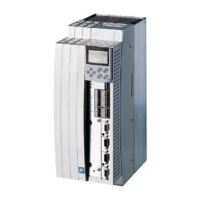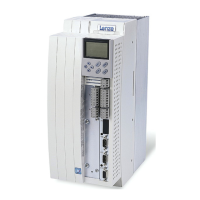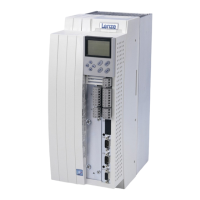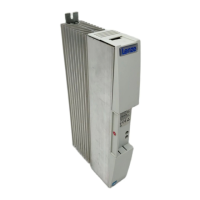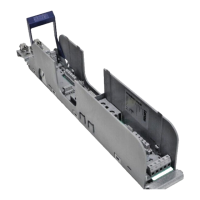9300 Servo PLC
Connection
3-27
9300ServoPLC EN 1.4
Axis synchronization via system bus (CAN)
The system bus (CAN) transmits the sync telegram as well as the process signals (for further
information refer to Part 3 ”Networking”).
Application examples:
• Input of cyclic, synchronized position setpoint information for multi-axis applications via the
system bus (CAN).
Axis synchronization via terminal control (X5/E5)
The sync signal and the process signals have different transmission routes.
• The process signals are added via a selectable input channel (e.g. AIF interface, DF input).
• The sync signal is entered via terminals X5 / E5.
Application examples:
• Input of cyclic, synchronized position setpoint information for multi-axis applications via other
bus systems (e.g. INTERBUS).
• Synchronization of internal processing cycles of the FB on higher-level process controls.
Synchronization cycle time
For the synchronization via the system bus (CAN) the master (e.g. PLC) sends a periodic sync
telegram.
For the synchronization via Terminal
the master sends a periodic sync signal.
The controllers (slaves) receive the sync telegram/signal and compare the time between two
LOW-HIGH edges of the signal to the cycle time set (C1121).
Code LCD
Possible settings
IMPORTANT
Lenze Choice
[C1121] Sync cycle 2 1{1msec}13Synchronization cycle
Definition of the cycle time of the
sync telegram/signal.
A parameterization is required only
for the slave.
• C1120 = 1 (Synchronization via system bus)
The value set under C1121 is the time between two sync telegrams of the master.
• C1120 = 2 (Synchronization via terminal)
The value set under C1121 is the time between two sync signals (LOW-HIGH edge)of the master at
X5/E5.
Phase shift
Code LCD
Possible settings
IMPORTANT
Lenze Choice
[C1122] Sync phase 0 0 {0.001 ms} 6.5 Synchronization phase
Phase shift between the sync
telegram/signal and the start of the
internal control program.

